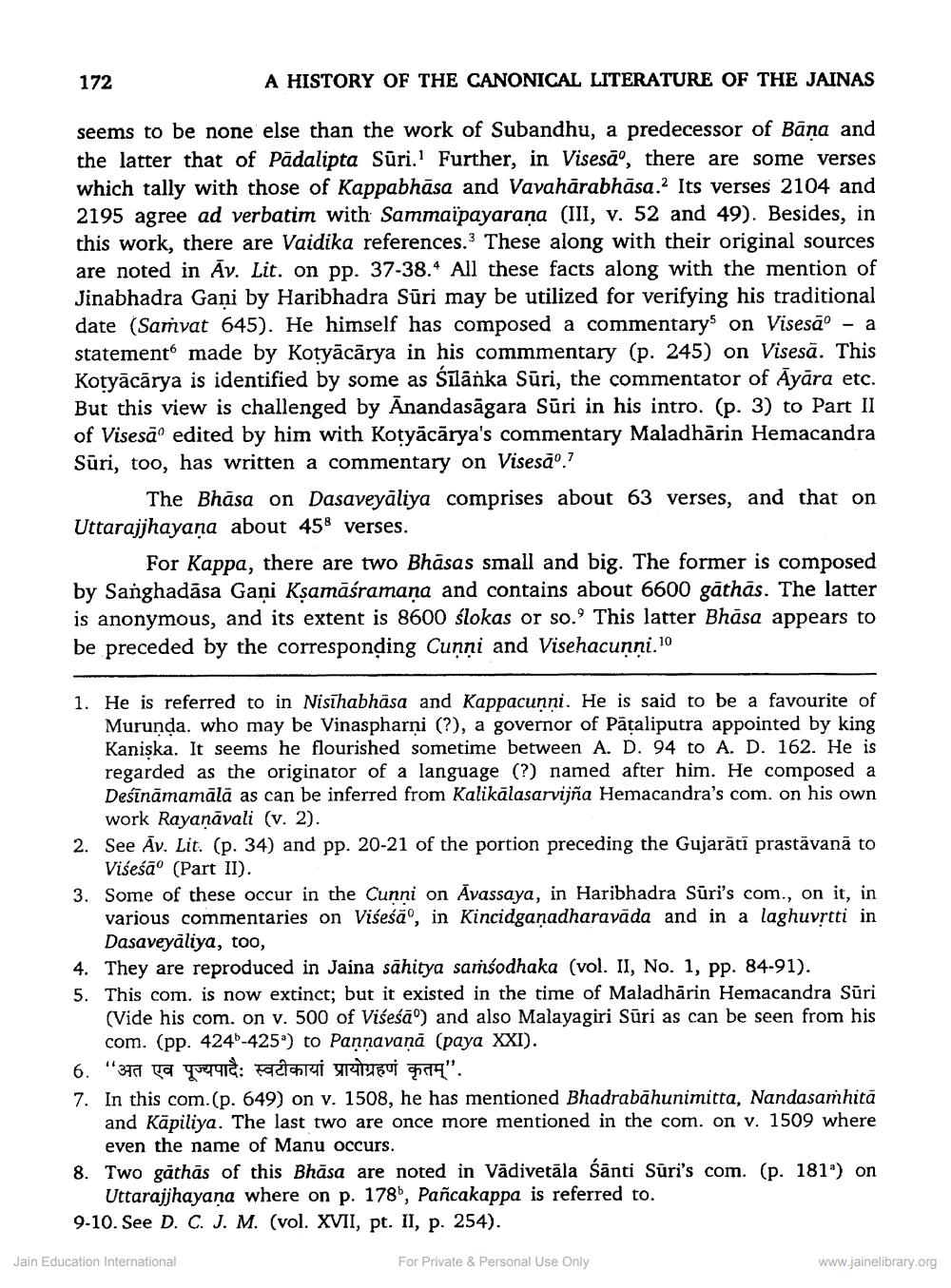________________
172
A HISTORY OF THE CANONICAL LITERATURE OF THE JAINAS
seems to be none else than the work of Subandhu, a predecessor of Bana and the latter that of Padalipta Sūri. Further, in Visesa”, there are some verses which tally with those of Kappabhāsa and Vavahārabhāsa.? Its verses 2104 and 2195 agree ad verbatim with Sammaipayarana (III, v. 52 and 49). Besides, in this work, there are Vaidika references. These along with their original sources are noted in Āv. Lit. on pp. 37-38.4 All these facts along with the mention of Jinabhadra Gani by Haribhadra Sūri may be utilized for verifying his traditional date (Saṁvat 645). He himself has composed a commentary on Visesā - a statement made by Kotyācārya in his commmentary (p. 245) on Visesā. This Kotyācārya is identified by some as Sīlanka Sūri, the commentator of Ayara etc. But this view is challenged by Anandasāgara Sūri in his intro. (p. 3) to Part II of Visesão edited by him with Kotyācārya's commentary Maladhārin Hemacandra Sūri, too, has written a commentary on Visesão.?
The Bhāsa on Dasaveyāliya comprises about 63 verses, and that on Uttarajjhayaņa about 458 verses.
For Kappa, there are two Bhāsas small and big. The former is composed by Sanghadāsa Gani Kșamāśramana and contains about 6600 gāthās. The latter is anonymous, and its extent is 8600 slokas or so. This latter Bhāsa appears to be preceded by the corresponding Cunni and Visehacunni.10
1. He is referred to in Nisthabhāsa and Kappacunni. He is said to be a favourite of
Murunda. who may be Vinaspharni (?), a governor of Pātaliputra appointed by king Kaniska. It seems he flourished sometime between A. D. 94 to A. D. 162. He is regarded as the originator of a language (?) named after him. He composed a Deśīnāmamālā as can be inferred from Kalikālasarvijña Hemacandra's com. on his own
work Rayanāvali (v. 2). 2. See Av. Lit. (p. 34) and pp. 20-21 of the portion preceding the Gujarātī prastāvanā to
Višeśão (Part II). 3. Some of these occur in the Cunni on Avassaya, in Haribhadra Sūri's com., on it, in
various commentaries on Viseśä', in Kincidganadharavāda and in a laghuvetti in
Dasaveyaliya, too, 4. They are reproduced in Jaina sahitya samsodhaka (vol. II, No. 1, pp. 84-91). 5. This com, is now extinct; but it existed in the time of Maladhärin Hemacandra Sūri
(Vide his com. on v. 500 of Višeśā) and also Malayagiri Sūri as can be seen from his
com. (pp. 4246-425') to Pannavanā (paya XXI). 6. "370 ta yoeleng: Fachrİ R EUT 794". 7. In this com.(p. 649) on v. 1508, he has mentioned Bhadrabāhunimitta, Nandasamhita
and Kāpiliya. The last two are once more mentioned in the com. on v. 1509 where
even the name of Manu occurs. 8. Two gāthās of this Bhāsa are noted in Vādivetāla śānti Sūri's com. (p. 181") on
Uttarajjhayana where on p. 1785, Pañcakappa is referred to. 9-10. See D. C. J. M. (vol. XVII, pt. II, p. 254).
Jain Education International
For Private & Personal Use Only
www.jainelibrary.org




